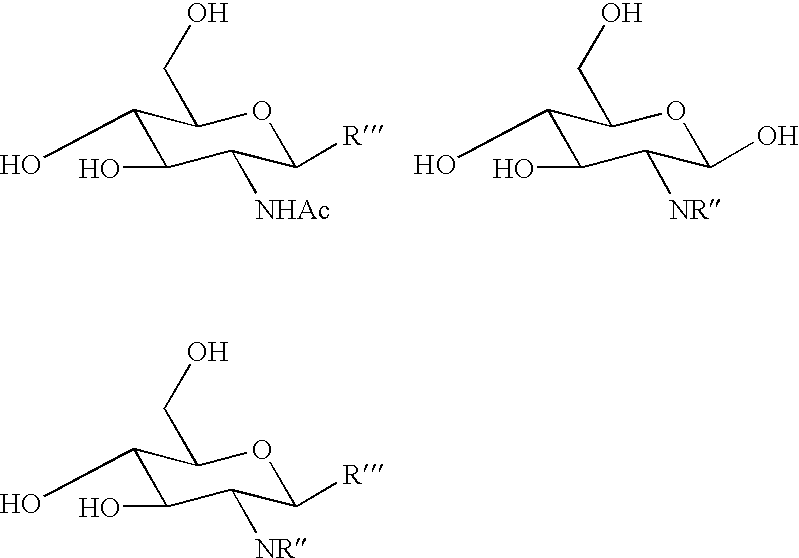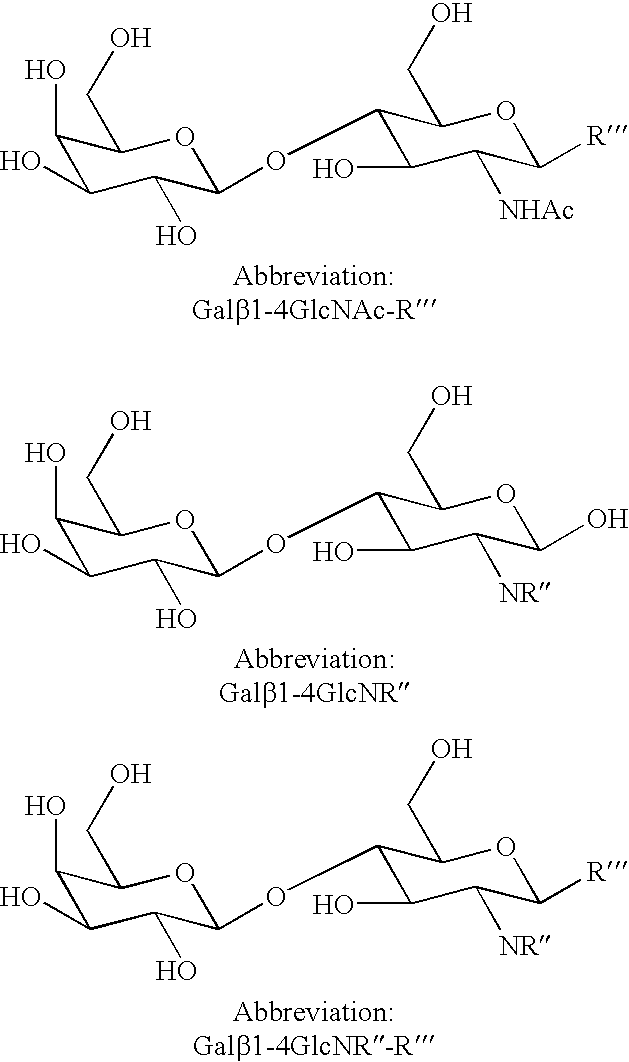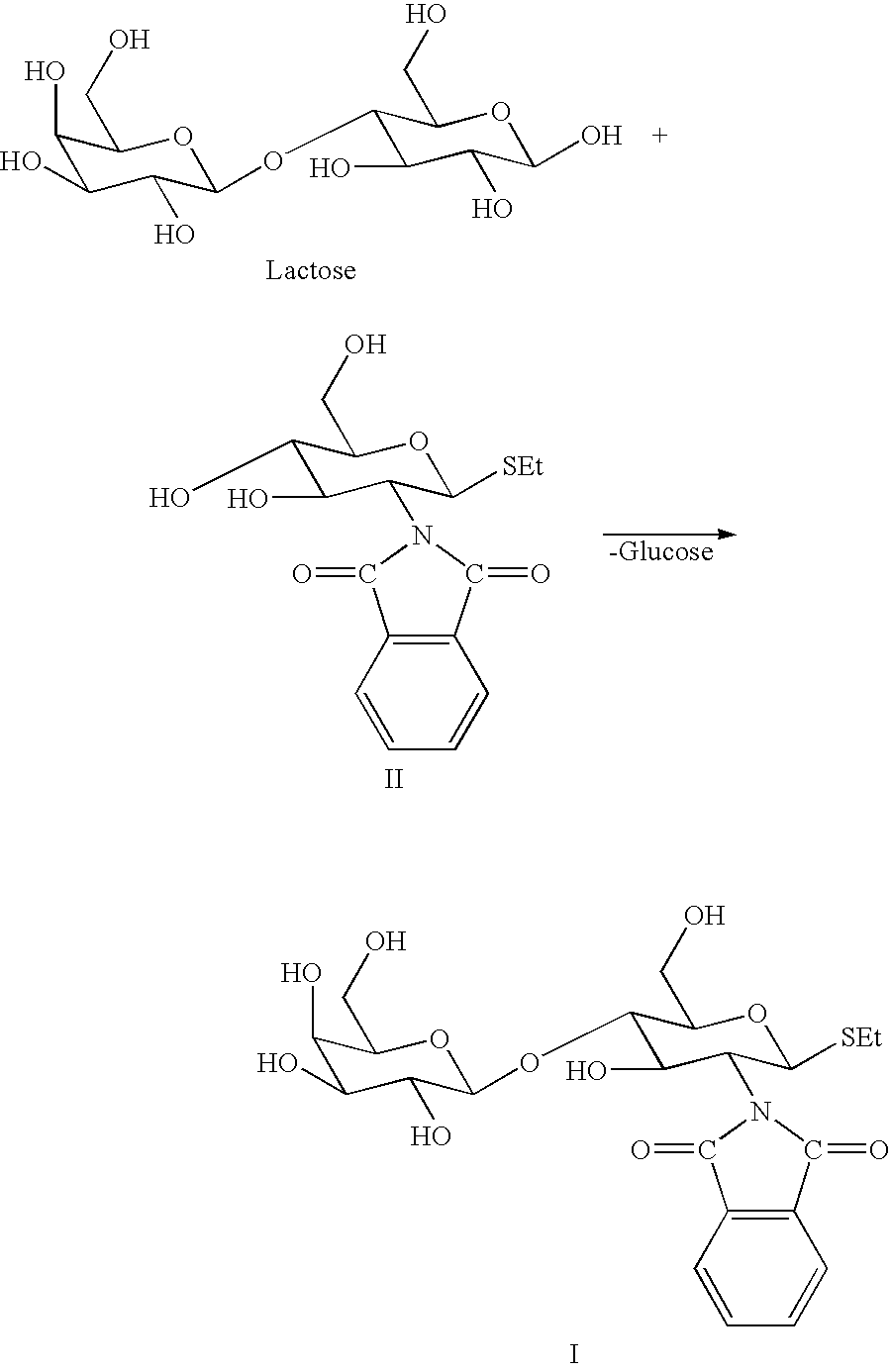Method of producing derivatives of lactosamine
a technology of lactosamine and derivatives, which is applied in the direction of sugar derivatives, disaccharides, enzymes, etc., can solve the problems of low efficiency of unnatural acceptors, low yield of n-acetyl-lactosamine, and multi-step synthesis of n-acetyl-lactosamine and derivatives thereo
- Summary
- Abstract
- Description
- Claims
- Application Information
AI Technical Summary
Benefits of technology
Problems solved by technology
Method used
Image
Examples
example i
The synthesis of Gal.beta.1-4GlcNPht.beta.SEt can be carried out as follows:
Bullera singularis is cultivated at 25.degree. C. during stirring in a medium of the following composition: 5% lactose, 1% GlcNPht.beta.SEt, which has been sterile filtered with yeast extract (Difco, 0.75% w / w in sodium acetate, pH 5.0). The reaction is carried out at 27.degree. C. until the lactose has been consumed to an appropriate extent. The product is isolated to homogeneity (no other sugar detected according to NMR) by the following procedure: after separation of yeast cells by centrifugation (or filtering), extraction of the water-phase with ethyl acetate to remove excess of acceptor, followed by butanol extraction of the water-phase and evaporation of the butanol-phase, followed by dissolution of the residue in water-ethanol, evaporation of ethanol, and precipitation of the product from water.
Isolation of the product is carried out for example by extraction of the water-phase with a suitable solvent...
example 1
Synthesis of Gal.beta.1-4GlcNPht.beta.-SEt (Compound I) (SEt.dbd.SCH.sub.2 CH.sub.3 Group)
##STR3##
Typically, Compound I was prepared in a fermentation reaction or with a partially purified .beta.-galactosidase preparation (obtained after disintegration of yeast cells under high pressure (600 bar)) and centrifugation of the solid material which was then used for synthesis). In a typical reaction, the initial concentration of lactose (glycosyl donor) and GlcNPht.beta.-SEt (acceptor; compound II) were 5 and 1.2% (w / V), respectively in yeast medium (as described above). Yeast cells (Bullera singularis) were added (OD600 was ca 1 after addition of the yeast cells) and the fermentation was carried out at 27.degree. C. with moderate shaking (150 rpm) at pH 5.5 for five days. Alternatively, the partially purified galactosidase preparation was used as catalyst for the reaction. Instead of lactose as the glycosyl donor, the .beta.-linked nitrophenyl glycoside of galactose (e.g. Gal.beta.-OPhN...
example 2
Synthesis of Gal.beta.1-4GlcNPht.beta.-OMe (Compound III OMe.dbd.OCH.sub.3)
##STR4##
Typically, Compound III was prepared as in Example 1 in a fermentation reaction or with a crude .beta.-galactosidase preparation (obtained after disintegration of yeast cells in sodium acetate, 50 mM, pH 5, under high pressure at 600 bars). Centrifugation gave a solid material which was used for synthesis. In a typical reaction, the initial concentrations of lactose (glycosyl donor) and GlcNPht.beta.-SEt (acceptor; compound IV) were 7 and 2.5% (w / V), respectively, in 40 ml of 50 mM sodium acetate, pH 6.0. Crude .beta.-galactosidase preparation were added (ca 3 g) and the reaction was carried out at 30.degree. C. with gentle agitation at pH 6.0 for two days. Instead of lactose as the glycosyl donor, the .beta.-linked nitrophenyl glycoside of galactose, Gal.beta.-OPhNO.sub.2 -o, was used as glycosyl donor (0.15 M)
The reaction was followed by TLC and by measurement of liberated nitrophenol at 405 nm (for...
PUM
| Property | Measurement | Unit |
|---|---|---|
| temperature | aaaaa | aaaaa |
| temperatures | aaaaa | aaaaa |
| temperatures | aaaaa | aaaaa |
Abstract
Description
Claims
Application Information
 Login to View More
Login to View More - R&D
- Intellectual Property
- Life Sciences
- Materials
- Tech Scout
- Unparalleled Data Quality
- Higher Quality Content
- 60% Fewer Hallucinations
Browse by: Latest US Patents, China's latest patents, Technical Efficacy Thesaurus, Application Domain, Technology Topic, Popular Technical Reports.
© 2025 PatSnap. All rights reserved.Legal|Privacy policy|Modern Slavery Act Transparency Statement|Sitemap|About US| Contact US: help@patsnap.com



